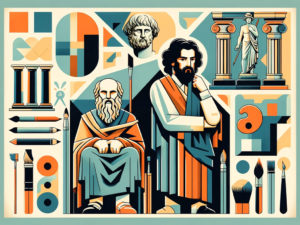Full book summary of “Picture This” – another novel by Joseph Heller, published in 1988 after “God Knows”. This work is known for its satirical take on philosophy, art, and the nature of reality, much in the vein of Heller’s earlier writings.
Short Recap
 Joseph Heller transports the reader through time, using Rembrandt’s painting “Aristotle Contemplating a Bust of Homer” as a central motif to connect different historical eras. The narrative explores the life of Rembrandt as he struggles with financial ruin in seventeenth-century Holland, simultaneously delving into the philosophical insights of Aristotle in ancient Greece.
Joseph Heller transports the reader through time, using Rembrandt’s painting “Aristotle Contemplating a Bust of Homer” as a central motif to connect different historical eras. The narrative explores the life of Rembrandt as he struggles with financial ruin in seventeenth-century Holland, simultaneously delving into the philosophical insights of Aristotle in ancient Greece.
As the story unfolds, Heller draws parallels between the socio-economic conditions of Rembrandt’s time and those of Aristotle’s, touching on themes of wealth, power, and the role of art in society. He also draws connections to contemporary America, critiquing modern politics and economics through the lens of the past.
The novel is less about a linear plot and more about the ideas and observations that arise from the juxtaposition of the lives of these two historical figures, the painting that connects them, and the author’s own commentary on the absurdities of human civilization across the ages.
Section-by-Section Summary of “Picture This”
Rembrandt’s Struggle
Rembrandt Harmenszoon van Rijn, the famous Dutch painter, faces poverty and obscurity towards the end of his life. His financial woes and the societal indifference to his art serve as a backdrop for broader reflections on the value of art and the fickle nature of fame.
Aristotle’s Philosophy
The narrative shifts to ancient Greece, where Aristotle’s thoughts on ethics, politics, and art are examined. Heller discusses Aristotle’s influence and the ironic detachment of his philosophies from the turbulent reality of his time, including his own personal compromises.
The Painting’s Tale
The history of Rembrandt’s painting “Aristotle Contemplating a Bust of Homer” is recounted. Its journey through owners and countries reflects on the changing perceptions of value and the commodification of art.
America’s Reflection
The story juxtaposes the historical settings of Rembrandt and Aristotle with contemporary America, drawing parallels in political corruption, economic disparity, and cultural decay. The painting acts as a mirror, reflecting the perennial nature of certain human follies.
Socrates and Athens
The narrative delves into the life of Socrates and the political dynamics of ancient Athens, showing the tension between democratic ideals and the realities of political life.
The Golden Age of Holland
Heller reflects on the Dutch Golden Age, a period of great wealth and cultural achievement, questioning the true beneficiaries of this prosperity and the cost at which it came.
The Philosophers and the Tyrants
The discussion moves to the relationship between philosophers like Plato and Aristotle with the tyrants of their times, exploring the ethical implications of their engagements with power.
The Modern Parallels
The book concludes with a critical look at modern society, suggesting that despite centuries of progress, humans continue to grapple with the same moral and social issues.
Interesting Facts
- Interweaving of Historical and Fictional Elements: Heller blends fact with fiction, merging historical accuracy with speculative commentary, particularly in the lives and times of Rembrandt and Aristotle.
- Philosophical Inquiry: The novel serves as a vehicle for philosophical questions about art, wealth, power, and morality, using historical figures to explore these themes.
- Economic Commentary: “Picture This” reflects on the economic conditions of Rembrandt’s time, drawing parallels to modern-day America and commenting on the enduring nature of economic cycles and disparities.
- Art as a Central Character: Rembrandt’s painting “Aristotle Contemplating a Bust of Homer” is more than a subject; it’s a narrative device that connects different stories and epochs, making art a living participant in the book.
- Cyclical View of History: Heller suggests that history is not linear but cyclical, with human follies and societal issues recurring despite the passage of time.
- Critique of Philosophers: The novel scrutinizes the roles of philosophers in society, especially their engagements with political power and moral dilemmas.
- Reflections on Democracy: Through the lens of ancient Athens and the life of Socrates, Heller examines the complexities and contradictions of democratic governance.
- Heller’s Satirical Style: True to Heller’s signature style, the book employs satire to dissect and critique societal norms and historical romanticism.
- Unconventional Narrative Structure: The absence of a traditional chapter division in “Picture This” challenges readers to embrace a fluid and interconnected narrative style.
- Mixed Reviews: Upon release, “Picture This” garnered mixed critical reception, with some praising its intellect and others critiquing its cohesiveness, reflecting the divided opinions on Heller’s experimental approach.
Frequently Asked Questions About “Picture This”
What is the main theme of “Picture This”?
The main theme revolves around the examination of art, wealth, power, and the enduring patterns of human behavior throughout history, using the intersection of Rembrandt’s and Aristotle’s lives as a backdrop.
How does “Picture This” reflect on contemporary society?
Heller uses historical contexts to draw parallels to contemporary society, critiquing political corruption, economic inequality, and cultural superficiality, suggesting these issues are timeless.
Is there a protagonist in “Picture This”?
While there isn’t a traditional protagonist, Rembrandt and his painting “Aristotle Contemplating a Bust of Homer” serve as the central figures around which the narrative unfolds.
How does Heller portray Rembrandt and Aristotle in the novel?
Heller portrays them as complex figures, grappling with the social and philosophical challenges of their times, while also reflecting on their relevance to modern issues.
Why does Heller use an unconventional narrative structure in “Picture This”?
The unconventional structure allows Heller to fluidly move through time and place, drawing thematic connections between disparate historical periods and contemporary issues.
My Personal Review of “Picture This”
“Picture This” attempts to bite off more than it can chew. Heller, once celebrated for the piercing satire of “Catch-22“, stumbles with a narrative that feels more like a fragmented pastiche than a cohesive novel. His protagonists, Rembrandt and Aristotle, serve less as fleshed-out characters and more as mouthpieces for anachronistic musings that often read as forced.
The novel’s lack of structure, while innovative in theory, collapses under its own weight in practice, leaving the reader adrift in a sea of historical cynicism and philosophical name-dropping. It’s a piece that seems to pride itself on intellectualism yet fails to engage on a truly intellectual level. Heller’s wit, while sharp, cannot save the disjointed rambling that “Picture This” ultimately becomes, making the novel feel like a grandiose magic trick gone wrong – an illusion of depth with no real substance beneath the surface.
🗣️ Unleash your thoughts in the comments! Do you crown Heller the king of satire, or do you condemn “Picture This” as a royal mess? Don’t just stew in your opinions – spill them! 📚👑

Comments